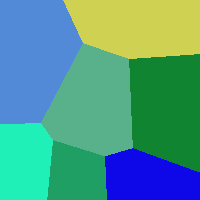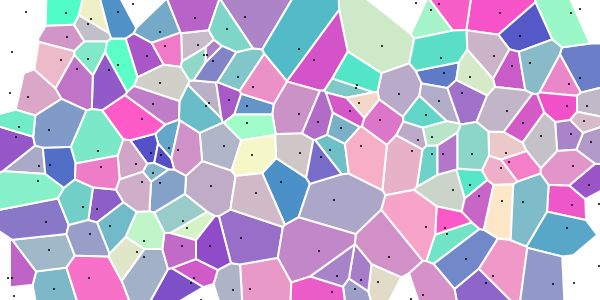Voronoi Fun
-
I'm translating some existing codes to Drawbot to generate custom Voronoi SVG, and am looking for suggestions. I'm starting with bezier paths or polygons. What would you use? (Don't give away the answer yet! I may still ask for more help later in the week.)
-
Ok, maybe I need a bit more assistance. Not sure how the PIL library codes can be translated to drawbot's methods of creating images.
https://rosettacode.org/wiki/Voronoi_diagram#PythonThis the the sample code I'm trying to translate to Drawbot:
from PIL import Image import random import math def generate_voronoi_diagram(width, height, num_cells): image = Image.new("RGB", (width, height)) putpixel = image.putpixel imgx, imgy = image.size nx = [] ny = [] nr = [] ng = [] nb = [] for i in range(num_cells): nx.append(random.randrange(imgx)) ny.append(random.randrange(imgy)) nr.append(random.randrange(256)) ng.append(random.randrange(256)) nb.append(random.randrange(256)) for y in range(imgy): for x in range(imgx): dmin = math.hypot(imgx-1, imgy-1) j = -1 for i in range(num_cells): d = math.hypot(nx[i]-x, ny[i]-y) if d < dmin: dmin = d j = i putpixel((x, y), (nr[j], ng[j], nb[j])) image.save("VoronoiDiagram.png", "PNG") image.show() generate_voronoi_diagram(500, 500, 25)
-
hello @bic,
the PIL example in your second post creates a Voronoi diagram as a raster image. in DrawBot, raster images can be created from scratch using ImageObject.
don’t forget that color coordinates in DrawBot are expressed as floats between
0.0and1.0, not as integers between0and255like in PIL. (so you’ll need to userandom()instead ofrandrange(256)to generate the RGB color values)
it works
 give it a try!
give it a try!
-
@gferreira Thanks! I was actually trying to generate a custom sized eps. Maybe this is the wrong approach. Matplotlib generates something similar very easily with the scipy.spatial libary...but ugly....
-
Voronoi is a lot of fun indeed. I gave
scipy.spatial.Voronoia try, and got it to work (sort of; some polygons are missing):
# based on http://stackoverflow.com/questions/27548363/from-voronoi-tessellation-to-shapely-polygons from random import randrange from scipy.spatial import Voronoi size(600, 300) pointsAmount = 160 points = [(randrange(width()), randrange(height())) for i in range(pointsAmount)] V = Voronoi(points) regions = [V.vertices[line] for line in V.regions if -1 not in line] stroke(1) strokeWidth(2) for R in regions: pts = [(float(x), float(y)) for x, y in R] if len(pts): fill(random(), random(), 0.7, 0.7) polygon(*pts) r = 1 stroke(None) fill(0) for x, y in points: oval(x-r, y-r, r*2, r*2) saveImage('voronoi-drawbot-2.png')and here is the bitmap version ported from PIL
happy voronoiing!